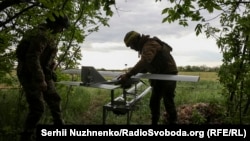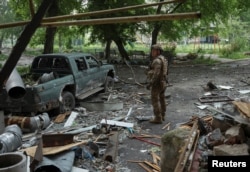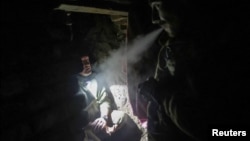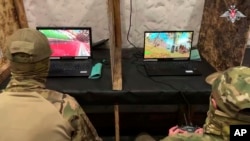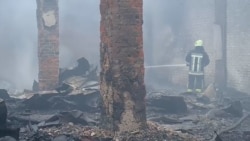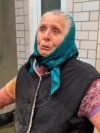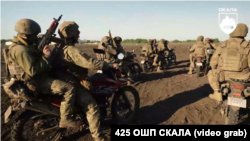Sometime around May 13, two battle-hardened Russian motor rifle regiments pushed into the ruined village of Nova Poltavka, crossing the T0504 highway that links the Ukrainian holdout cities of Pokrovsk and Kostyantynivka.
The road has served as a critical supply line for Ukrainian forces and their battered defensive lines along a 100-kilometer section of the front.
Military experts say the loss of the highway is unlikely to lead to an immediate collapse of the Ukrainian lines. Still, it doesn't make things any easier for the beleaguered Ukrainian armed forces.
That's all the more true now that the summer fighting season has shifted into high gear and as signs point to what could be a major offensive by Russian forces in the coming weeks.
More than 40 months into Russia's all-out assault, Ukraine is still losing ground to a larger, better-equipped Russian military. But Ukraine is punching back, inflicting eyewatering casualties on Moscow's forces. At current rates, Russia is on track to record more than 1 million dead and wounded by year's end.
Russian President Vladimir Putin "and his inner circle are not planning to end the war," Ukrainian President Volodymyr Zelenskyy said on May 26 . "In fact, there is a lot of evidence that they are preparing for a new offensive. Russia is planning for continued war."
A Long, Hot Summer?
The winter lull in larger operations across most of the nearly 1,100-kilometer front line was attributed mainly to Russia reconstituting its units and replenishing its arsenals. Winter mud made it difficult for both sides' heavy vehicles to cross fields. Winter skies made it difficult for Russia's air force to barrage Ukrainian positions with heavy glide bombs.
That's changed in recent weeks.
Russian forces have advanced at a faster clip lately, said Emil Kastehelmi, a military analyst with the Black Bird Group, a Finnish-based monitoring organization.
The T0504 highway had been a good route for supply and transport, he said, but it's been largely out of service for Ukrainian troops since January 2025, when a bridge south of Nova Poltavka was destroyed.
Still, "there is no actual breakthrough in the Nova Poltavka area in the true sense of the word," he told RFE/RL.
"A breakthrough would mean that the defenses would collapse in a more rapid and serious manner, so that the enemy's mechanized forces could quickly exploit the situation and advance deep into the defender's rear," he said. "However, at the moment, the advance is taking place at a relatively moderate pace, even though it's quicker than what we've seen this year."
The increasing tempo of operations has kindled fears that Russia is planning for a wider offensive this summer -- perhaps a push to take the sections of Ukraine's Kherson, Donetsk, and Zaporizhzhya regions that it currently doesn't hold, something Putin and his advisers have said is a priority.
"It's likely we will see intensified fighting especially in Donetsk as the summer progresses," Kastehelmi said.
Russia's offensive will likely have a "soft launch with a steady increase in the number and scale of assaults across a broadening area around the main axis," said Jack Watling, a senior research fellow at the Royal United Services Institute, a London think tank.
"Indeed, there are indications this process has already started," Watling said in a report released May 20 .
"The main Russian effort into the summer will once again be against the key towns of Kostyantynivka and Pokrovsk. Russian forces continue to plan against orders to complete the occupation of Donetsk," he said.
Ukraine's main weaponry supplier -- the United States – has turned off the spigot for now, the result of President Donald Trump's administration trying to hammer out a cease-fire between Moscow and Kyiv.
That's already causing problems for some frontline units.
But if Ukrainian units can hold back the Russian advances, it would likely lead to more support for the Ukrainian war effort in the West, said Mykola Byelyeskov, an analyst at the government-backed National Institute for Strategic Studies in Kyiv, or persuade Trump White House skeptics to toughen their policies toward Moscow.
"For war-weary Ukraine, the coming summer campaign will be a major test of endurance," he said in a blog post .
Attack Of The Drones
The proliferation of drones -- ground and aerial, surveillance and attack, autonomous and human-piloted -- have redefined how military commanders, engineers, planners, and even infantry officers think about the battlefield.
Soldiers on both sides report that it is difficult, if not impossible, to conduct traditional infantry-and-cavalry-style assaults -- where foot soldiers are trucked to an attack position in an armored vehicle to attack enemy positions while supported by heavy weaponry like tanks or armored fighting vehicles.
"What's occurring in Ukraine is you cannot move without being seen," Daniel Driscoll, secretary of the US Army, told a podcast earlier this month .
With a smaller population and smaller industrial base, Ukraine has embraced drones as a way to level the playing field with Russian forces. After being slow to recognize the technology, Russian forces have ramped up their own use of drones, relying on Iranian-designed Shahed drones and later, their own homegrown designs.
In February, Ukrainian authorities announced a new initiativecalled the Line of Drones -- an effort that restructured how some military units are organized and deployed into battle.
The effort "has been decisive in sustaining Ukraine's defensive and offensive capabilities," said Jorge Rivero, a retired US Marine officer and specialist on the Russian military at the Washington-area Institute for Defense Analyses. "Absent these changes, it is difficult to envision how Ukraine could have maintained its operational tempo or blunted recent Russian offensives," like in Pokrovsk.
In Pokrovsk, over the winter, Russian forces tried to inch their way into the garrison hub for supplying Ukrainian lines. However, Ukrainian units managed to push back some of the Russian lines.
"The Line of Drones demonstrates [how] Ukraine has transitioned from ad hoc drone use to an integrated, mass-produced capability that is generating tangible tactical and operational effects," he said.
For its part, Russia has also reportedly started setting up its own dedicated drone regiments , one of which is believed to have helped cut Ukrainian supply lines in Kursk, the Russian region that Ukraine invaded last summer.
Aside from battlefield targets, Russia has tapped its drone arsenal to hammer civilian targets in Ukraine: apartment buildings, electric power stations, bridges.
Since May 26, Russia has launched more than 1,390 drones at nonmilitary targets, according to Ukraine's air force. An overnight attack on May 26 was the largest in terms of sheer numbers since the start of the all-out invasion, officials said.
Biker Gangs
Until recently, big, heavy vehicles -- tanks, personnel carriers, infantry fighting vehicles -- were the weapon of choice for modern ground armies. In Ukraine, however, they're increasingly vulnerable, as drones become more powerful and more ubiquitous.
Enter the motorcycle.
Both Ukraine and Russia are turning to off-road motorbikes, which are fast, versatile -- and have no protection whatsoever.
Russian forces have employed biker units for months now; a Defense Ministry promotional video released April 26 described one unit as "paratroopers on iron horses."
Ukrainian forces reported a combined Russian assault involving motorcycles near Bahatyr, south of Pokrovsk.
And earlier in April, a Russian unit attempted crossing the Oskil River, north of Kupyansk, combining armored vehicles with motorbikes, said Lieutenant Colonel Pavlo Shamshyn, a spokesman for Ukraine's Kharkiv region operations.
"The main task is to quickly get from point A to point B. Using motorcycles to do this is not the safest thing, but let's say, you end up suffering many fewer losses," he said in comments to Suspilne, Ukraine's public broadcaster.
"Imagine if there are 50 motorcycles riding across a field, how many…drones do you need to use to destroy them all?" he said .
"And they move pretty fast -- if they need to get across a field 1 1/2 kilometers long, they will spend three to five minutes on it, and the drone needs to be equipped, launched, and then fired," he said.
Seeking to copy some of the Russian tactics, Ukrainian commanders have set up their own motorbike units. The 425th Separate Assault Regiment this month released what amounted to a recruiting video, showing soldiers training for quick maneuver assaults using off-road bikes, two lightly armed soldiers to a bike.
Russia, with its larger military and larger population to recruit from, can afford the high losses that come from motorcycle assaults, said Oleksandr Kovalenko, a Ukrainian military commentator.
"Ukraine should not fight with these methods. Our task is to minimize our losses and maximize the enemy's losses," he said in a post to Telegram . "And the use of motorcycles in assaults will not help to fulfill this plan."




